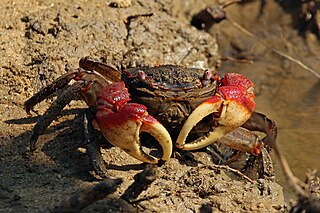Related Research Articles

Rhithropanopeus harrisii, is a small omnivorous crab native to Atlantic coasts of the Americas, from New Brunswick to Veracruz.

The Ocypodidae are a family of semiterrestrial crabs that includes the ghost crabs and fiddler crabs. They are found on tropical and temperate shorelines around the world.

The Grapsoidea are a superfamily of crabs; they are well known and contain many taxa which are terrestrial (land-living), semiterrestrial, or limnic. Another well-known member with a more conventional lifestyle is the Chinese mitten crab, Eriocheir sinensis.

Lake Poso is a lake in Central Sulawesi, Indonesia, and the third-deepest lake in Indonesia.

Lake Towuti is a lake in South Sulawesi, Indonesia. Surrounded by mountains, it is the largest lake of the island of Sulawesi and one of the five lakes of the Malili Lake system. A river flows from the lake to the Boni Bay. The town Laronda is located on its shore.

Lake Matano, also known as Matana, is a natural lake in South Sulawesi, Indonesia. With a depth of 590 m (1,940 ft), it is the deepest lake in Indonesia, the 10th deepest lake in the world and the deepest lake on an island by maximum depth. The surface elevation from mean sea level is only 382 m (1,253 ft), which means that the deepest portion of the lake is below sea level (cryptodepression). It is one of the two major lakes in the Malili Lake system.

The Sesarmidae are a family of crabs, previously included in the Grapsidae by many authors. Several species, namely in Geosesarma, Metopaulias, and Sesarma, are true terrestrial crabs. They do not need to return to the sea even for breeding.
Sesarma is a genus of terrestrial crabs endemic to the Americas.

Potamon fluviatile is a freshwater crab found in or near wooded streams, rivers and lakes in Southern Europe. It is an omnivore with broad ecological tolerances, and adults typically reach 50 mm (2 in) in size during their 10–12 year lifespan. They inhabit burrows and are aggressive, apparently outcompeting native crayfish.

Potamon is a genus of freshwater or semiterrestrial crabs mainly found from Southern Europe through the Middle East, and as far east as north-western India. The only exception is the North African P. algeriense, which also is the only potamid of mainland Africa. Twenty species are currently recognised:. These crabs are omnivores that have a broad ecological tolerance. The adult Potaman reach up to 50 mm in size during their 10-12 year life span.

Austruca mjoebergi is a species of fiddler crab discovered by and named after the Swedish zoologist Eric Mjöberg (1882–1938), member of a Swedish scientific expedition to Australia in the early 1900s.

Austruca perplexa is a species of fiddler crab. It is found from the Ryukyu Islands, Japan to India, throughout the Malay Archipelago, along eastern Australian coasts from Queensland to New South Wales, and in various Pacific islands, including Fiji, Tonga and Vanuatu.

Gelasimus vocans is a species of fiddler crab. It is found across the Indo-Pacific from the Red Sea, Zanzibar and Madagascar to Indonesia and the central Pacific Ocean. It lives in burrows up to 50 centimetres (20 in) deep. Several forms of U. vocans have been recognised, with their authors often granting them the taxonomic rank of full species or subspecies.
Cyrtocarcinus truncatus is a species of crab in the family Xanthidae that lives in the waters around Hawaii. It was described in 1906 by Mary J. Rathbun as Harrovia truncata, based on a single immature male specimen caught near Kauai. Masatsune Takeda transferred the species to his new genus Glyptocarcinus in 1979, and Peter Ng and Diana Chia erected a new genus, Cyrtocarcinus, for this species alone, in 1994.

Seychellum alluaudi is a species of freshwater crab endemic to the Seychelles, and the only true freshwater crab in that country. It lives in rainforest streams on the archipelago's granitic high islands. Although it may be abundant, little is known about its biology. If its habitat were to decline in quality, S. alluaudi might become endangered, but it is currently listed as Vulnerable on the IUCN Red List.
Cancrocaeca xenomorpha is a species of troglobitic (cave-dwelling) freshwater crab from Sulawesi, the only species in the monotypic genus Cancrocaeca. It has been described as the world's "most highly cave-adapted species of crab".
Syntripsa flavichela is a species of freshwater crab found in Lake Towuti and Lake Mahalona on the Indonesian island of Sulawesi.
Migmathelphusa olivacea is a species of freshwater crab found in Lake Poso on the Indonesian island of Sulawesi. It is the only species in its genus. It is listed by the IUCN as Endangered, given "its extent of occurrence and area of occupancy is less than 500 square kilometres (190 sq mi)", and its individuals being found in less than five locations. There is also a "decline in the extent and quality of its habitat and it is not found in a protected area". Being found around a lake, "present and future threats to this species include human-induced habitat loss/degradation due to population increases and industrial and agrarian development".
Dennerle is a German company producing aquarium and pond supplies.

Austruca is a genus of indo-west Pacific fiddler crabs in the family Ocypodidae. There are about 13 described species in this genus.